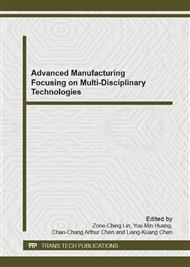[1]
G. Buffa, L. Fratini , M. Piacentini, On the Influence of Tool Path in Friction Stir Spot Welding of Aluminum Alloys, Journal of Materials Processing Technology, 208 (2008) 309-317.
DOI: 10.1016/j.jmatprotec.2008.01.001
Google Scholar
[2]
B. Tweedy, C. Widener, J. Merry, J. Brown, D. Burford, Factors Affecting the Properties of Swept Friction Stir Welds, SAE Technical Paper, Society of Automotive Engineers, Detroit, (2008) 14-17.
DOI: 10.4271/2008-01-1135
Google Scholar
[3]
J. Brown, C. Widener, G. Moore, K. Poston, D. Burford, Evaluation of Swept Friction Stir Spot Welding in Al 2219-T6, TMS 2009 Annual Meeting, California, (2009) 215-223.
Google Scholar
[4]
J. Brown, C. Widener, D. Burford, W. Horn, G. Talia, B. Tweedy, Corrosion and Fatigue Evaluation of Sept Friction Stir Spot Welding through Sealants and Surface Treatments, TMS 2009 Annual Meeting, California, (2009) 273-282.
Google Scholar
[5]
S. A. Gean, J. C. Westgate, J. C. Kucza, J. C. Ehrstorm, Static and Fatigue Behavior of Spot-Welded 5182-0 Aluminum Alloy Sheet, Welding Journal, 78 (1999) 80-86.
Google Scholar
[6]
J. A. Newman, N. E. Dowling, A Crack Growth Approach to Life Prediction of Spot-Welded Lap Joints, Fatigue Fracture Engineering Mater Structure (1998) 1123-32.
DOI: 10.1046/j.1460-2695.1998.00099.x
Google Scholar
[7]
S. H. Lin, J. Pan, P. Wung, J. Chiang, A Fatigue Crack Growth Model for Spot Welds in Various Types of Specimens under Cyclic Loading Conditions, International Journal of Fatigue (2006) 792-803.
DOI: 10.1016/j.ijfatigue.2005.08.003
Google Scholar
[8]
P. C. Lin, J. Pan, T. Pan, Failure Modes and Fatigue Life Estimations of Spot Friction Welds in Lap-Shear Specimens of Aluminum 6111-T4 Sheets, Part 1: Welds Made by A Concave Tool, International Journal of Fatigue (2008) 74-89.
DOI: 10.1016/j.ijfatigue.2007.02.016
Google Scholar
[9]
P. C. Lin, J. Pan, T. Pan, Failure Modes and Fatigue Life Estimations of Spot Friction Welds in Lap-Shear Specimens of Aluminum 6111-T4 Sheets, Part 2: Welds Made by a Flat Tool, International Journal of Fatigue (2008) 90-105.
DOI: 10.1016/j.ijfatigue.2007.02.017
Google Scholar
[10]
N. E. Dowling, Mechanical Behavior of Materials: Engineering Methods for Deformation, Fracture, and Fatigue, 2nd ed., Upper Saddle River, New Jersey, (1998).
Google Scholar
[11]
P. C. Lin, D. A. Wang, J. Pan, Mode I Stress Intensity Factor Solutions for Spot Welds in Lap-Shear Specimens, International Journal Solids Structure (2007) 1013-37.
DOI: 10.1016/j.ijsolstr.2006.05.031
Google Scholar
[12]
S. Zhang, Stress Intensities at Spot Welds, International Journal Fracture (1997) 167-85.
Google Scholar
[13]
D. A. Wang, S. H. Lin, J. Pan, Stress Intensity Factors for Spot Welds and Associated Kinked Cracks in Cup Specimens, International Journal of Fatigue (2005) 81-98.
DOI: 10.1016/j.ijfatigue.2004.08.008
Google Scholar
[14]
H. Tada, P. C. Paris, G. R. Irwin, The Stress Analysis of Crack Handbook, 2nd. ed., Paris Productions Inc., 226 Woodbourne Dr., St. Louis, MO 63105 , (1985).
Google Scholar
[15]
P. C. Lin, Z. M. Su, R. Y. He, Z. M. Lin, Failure Modes and Fatigue Life Estimations of Spot Friction Welds in Cross-Tension Specimens of Aluminum 6061-T6 sheets, International Journal of Fatigue 38 (2012) 25-35.
DOI: 10.1016/j.ijfatigue.2011.11.003
Google Scholar
[16]
P. R. Abelkis, J. M. Potter, Service Fatigue Loads Monitoring, Simulation, and Analysis: A Symposium, ASTM International (1979).
DOI: 10.1520/stp671-eb
Google Scholar


